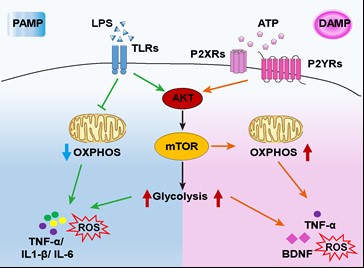On November 21, 2019, Glia published a study from Zhihua Gao and Shumin Duan’s group. The study, entitled “mTOR-mediated metabolic reprogramming shapes distinct microglia functions in response to lipopolysaccharide and ATP”, demonstrated different metabolic adaptations contribute to the distinct immunoresponses and functional states of microglia and suggest that mTOR is an important target to manipulate microglial metabolism and function.
Microglia constantly survey the microenvironment to maintain brain homeostasis under physiological conditions. Upon injuries or diseases, microglia quickly extend their processes and migrate toward the damaged sites to clear harmful substances and evoke immunoresponses by cytokine release. How cellular metabolism of microglia is wired to ensure their homeostatic dynamics and rapid responses to environmental changes in the brain remains largely unexplored.
In this article from Zhihua Gao and Shumin Duan’s team, they report thatmicroglia activation is accompanied by extensive transcriptional changes in glucose and lipid metabolism-related genes. Using metabolic flux assays, they found that LPS, a prototype of the pathogen-associated molecular patterns (PAMPs), significantly enhanced glycolysis but suppressed oxidative phosphorylation (OXPHOS) in primary cultured microglia. By contrast, ATP, a known damage-associated molecular pattern (DAMPs) that triggers sterile activation of microglia, boosted both glycolysis and OXPHOS. Importantly, both LPS and ATP activated the mechanistic target of rapamycin (mTOR) pathway. Inhibition of mTOR activity suppressed glycolysis in both conditions but exerted different effects on OXPHOS: it attenuated the ATP-induced elevation of OXPHOS, yet had no impact on the LPS induced suppression of OXPHOS. Further, inhibition of mTOR or glycolysis decreased production of LPS-induced proinflammatory cytokines and ATP-induced tumor necrosis factor-α (TNF-α) and brain derived neurotrophic factor (BDNF) in microglia. These data suggest that a critical role for mTOR in the regulation of metabolic programming of microglia to shape their distinct functions under different states and shed light on the potential application of targeting metabolism to interfere with microglia-mediated neuroinflammation in multiple disorders.
The first author of this paper is the PhD student Yaling Hu. The corresponding authors are Zhihua Gao and Shumin Duan. This work was supported by basic research program of Ministry of Technology of China, Natural Science Foundation of China.

Link to the article:https://onlinelibrary.wiley.com/doi/full/10.1002/glia.23760
A model depicting the role of mTOR in the regulation of metabolic programming of microglia to shape their distinct functions under different states





 Location :
Location : 

